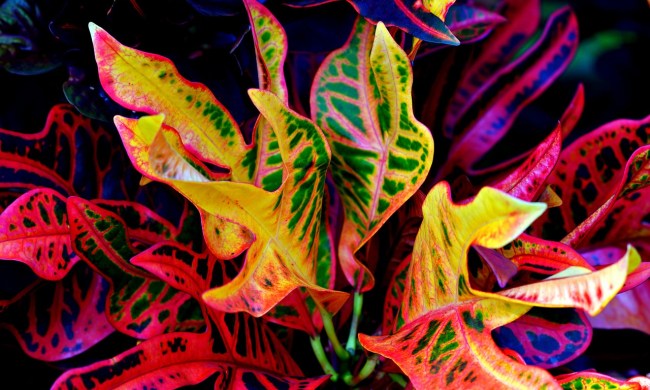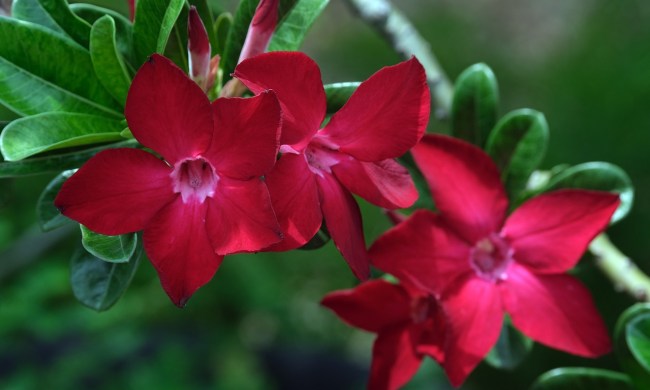If you’re on the lookout for a colorful houseplant, then there are many options to choose from. From the deep reds and oranges of fall to cooler, more dramatic purples and blues, you have plenty of plants to pick from. If you want something a bit brighter and more cheerful, then why not try a tradescantia nanouk? If you aren’t already familiar with this lovely variety of tradescantia, then you’re in for a treat! We’ll explain what makes this plant special and how you can grow your own in this guide to tradescantia nanouk care.
What is tradescantia nanouk?

Tradescantia nanouk is a variety of Tradescantia cerinthoides, closely related to the popular Tradescantia zebrina. If you’re a fan of zebrinas, you’ll be happy to know that nanouk shares a few characteristics with it, including colorful, striped leaves, tiny flowers, and trailing stems. However, tradescantia nanouk has less silver and a brighter shade of pink. The leaves can also feature cream along with the standard green. The leaves tend to be slightly larger than zebrinas, and the flowers are white, sometimes with pink-tipped petals (although the pink may be pale and hard to see on some plants).
The flowers don’t always appear on indoor plants, but when they do, you can begin to see them in mid-summer. Luckily, the foliage of the tradescantia nanouk is stunning enough to be worth growing, even if the flowers don’t appear.
Planting tradescantia nanouk

Choose a container with drainage holes and use rich, well-draining soil. Nanouk enjoys consistently moist soil, but it cannot handle soggy soil. Some gardeners use cactus soil, but others find just as much success with regular potting soil amended with compost, sand, or perlite. Remember, you can always add more water if your soil drains too quickly, but you can’t remove water from the soil if it drains too slowly, so err on the side of caution.
Bright, indirect light or filtered light is ideal for tradescantia nanouk. While it can handle some direct light and some shade, both can cause problems for it over time. Too much direct sunlight can burn the leaves, causing the edges to turn brown, while too much shade can cause the leaves to lose some of their vibrancy. Avoid placing your tradescantia nanouk near drafts or air vents, as the air blowing across the leaves will be cooler and drier than your nanouk likes.
Tradescantia nanouk care

Water your tradescantia nanouk when the soil is beginning to dry out. Check the soil semi regularly or use a moisture meter to avoid leaving it too long, as these plants don’t tolerate long droughts very well. The leaves of the tradescantia nanouk are another good indicator, as they will begin to wilt or go limp when the plant needs water.
However, you should take care to avoid getting the leaves wet when watering your tradescantia nanouk. While consistently damp leaves can cause problems for any plant, tradescantia nanouk is particularly sensitive to wet leaves. If the leaves are left wet, they can stiffen and turn brown, which is unattractive and unhealthy for your plant. To avoid this, some gardeners prefer to use a self-watering planter with tradescantia nanouk.
Tradescantia nanouk does best in moderate to high humidity. There are a number of ways you can raise the humidity around your plant, but due to its dislike of wet leaves, we recommend against misting this plant. Instead, use a humidity tray or humidifier if your tradescantia nanouk is beginning to dry out.
During spring and summer, you can give your tradescantia nanouk a boost with a balanced houseplant fertilizer. They aren’t picky eaters, and any balanced fertilizer will work to encourage healthy growth. We recommend a liquid or water-soluble fertilizer that you can easily incorporate into your watering routine, but they will do just as well with a slow-release granulated fertilizer.
Tradescantia nanouk doesn’t typically have problems with larger pests, but they can become the targets of smaller common houseplant pests. Spider mites, aphids, mealybugs, and thrips can bother your nanouk. These pests are small, but can do serious damage in large numbers. Luckily, they’re also easy to get rid of with an insecticidal soap or neem oil.
Tradescantia nanouk is a beautiful plant, and while it can be a bit particular about some things, it is easy to grow if you are patient and attentive. So why not bring a tradescantia nanouk seedling home with you today? Before long, you’ll be enjoying the bright, cheerful colors of this lovely tradescantia variety!




